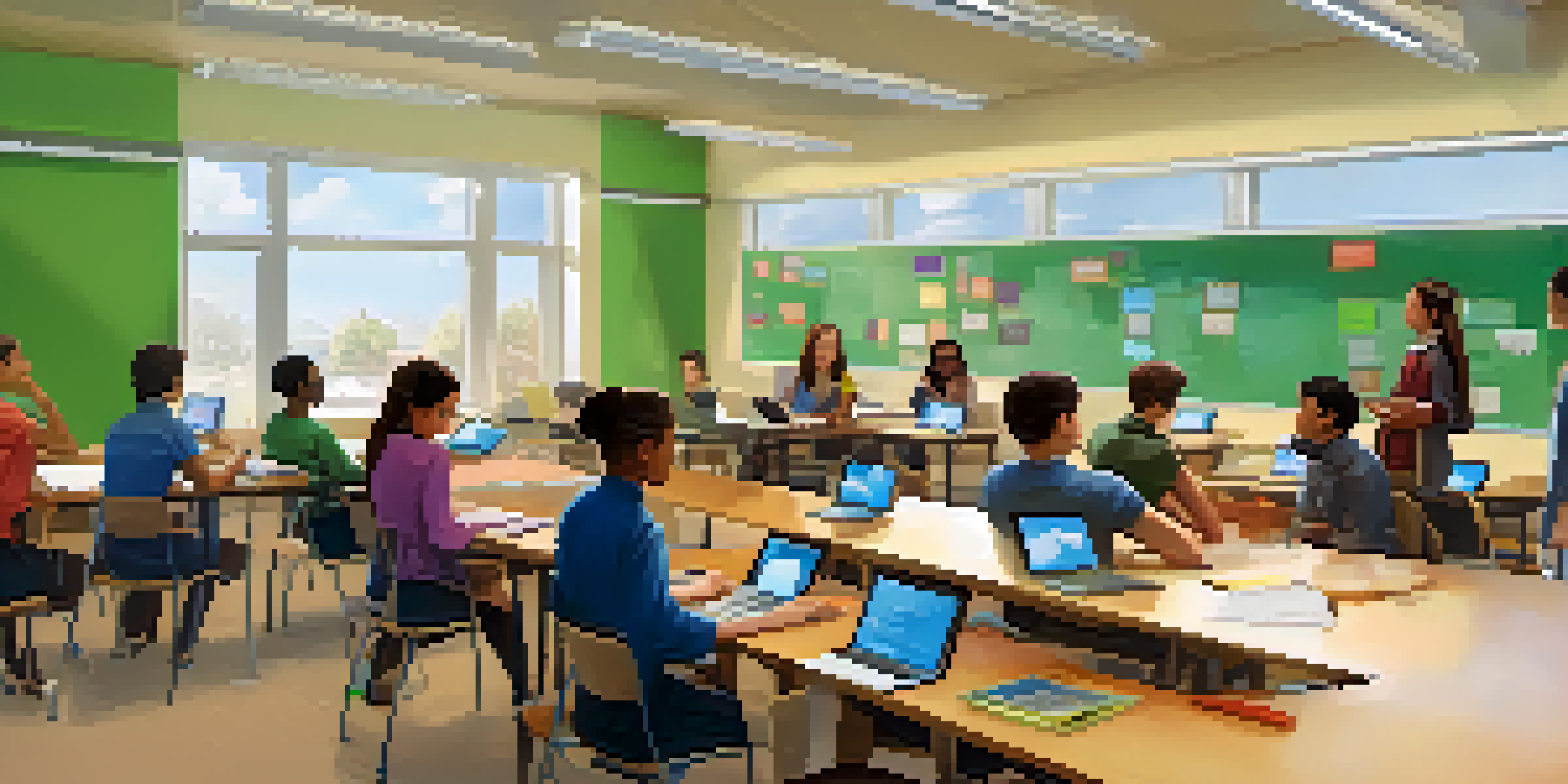Key Components of Successful Blended Learning Frameworks

Understanding Blended Learning: A Balanced Approach
Blended learning combines traditional face-to-face instruction with online learning activities. This approach allows educators to leverage technology while maintaining personal interaction with students. By integrating various learning methods, blended learning caters to diverse learning styles and paces, ensuring a more inclusive educational experience.
Blended learning is not just a mix of online and face-to-face; it's a transformative approach that caters to diverse learning needs.
For example, a classroom might utilize online platforms for quizzes and discussions while reserving in-person sessions for hands-on activities and group work. This blend not only keeps students engaged but also fosters a sense of community, essential for effective learning. It's this balance that sets blended learning apart from purely online or traditional methods.
Ultimately, understanding how to blend these two modalities effectively is crucial for creating a robust learning environment. As educational needs evolve, so too must our strategies for teaching and learning, making blended frameworks an increasingly popular choice.
Setting Clear Learning Objectives for Success
Clear learning objectives are the foundation of any successful blended learning framework. They guide the entire educational process, helping educators focus on what students need to achieve. By establishing specific, measurable goals, instructors can tailor their teaching strategies to meet the needs of their students effectively.

For instance, if a learning objective is to enhance critical thinking skills, educators can design activities that encourage analysis and evaluation of information. This could involve online case studies followed by in-class discussions. Clear goals not only motivate students but also provide a roadmap for assessing their progress throughout the course.
Blended Learning Combines Methods
Blended learning merges traditional and online instruction to create a more inclusive educational experience.
Incorporating these objectives into both online and face-to-face components ensures alignment and maximizes the learning experience. When students understand what they are expected to learn, they are more likely to engage actively and take ownership of their educational journey.
Leveraging Technology to Enhance Learning Experiences
Technology plays a pivotal role in blended learning, offering tools that enhance the educational experience. From learning management systems (LMS) to interactive apps, the right technology can facilitate collaboration and provide access to a wealth of resources. This not only enriches content but also caters to various learning styles.
The best teaching is not about the content, but about the relationships we create and the connections we make.
For example, using video tutorials allows visual learners to grasp concepts better, while discussion forums can engage those who thrive on interaction. Moreover, technology enables real-time feedback, giving students immediate insights into their performance and areas needing improvement. This instant feedback loop is invaluable for learning.
However, it's essential to choose technology wisely, ensuring it aligns with learning objectives and enhances rather than distracts from the educational process. A well-integrated technological framework can transform a traditional learning environment into a dynamic, interactive space.
Creating an Engaging and Inclusive Learning Environment
An engaging and inclusive learning environment is vital for the success of blended learning. When students feel valued and included, they are more likely to participate actively and contribute to discussions. An inclusive approach recognizes diverse backgrounds, learning styles, and needs, fostering a sense of belonging.
For instance, incorporating collaborative projects can encourage teamwork and peer learning, where students learn from each other's strengths. Using varied instructional methods—such as group discussions, hands-on activities, and online modules—also caters to different preferences. This variety keeps students engaged and motivated.
Clear Objectives Drive Success
Establishing specific learning objectives helps educators tailor their strategies and motivates student engagement.
Additionally, creating a safe space where students feel comfortable expressing their ideas and questions promotes open communication. In such an environment, learners are empowered to take risks and explore new concepts, leading to deeper understanding and retention.
Implementing Continuous Assessment and Feedback Loops
Continuous assessment is a critical component of blended learning frameworks, allowing educators to monitor student progress effectively. Rather than relying solely on end-of-term exams, ongoing assessments provide insights into how well students are grasping material. This approach helps identify areas where additional support may be needed.
For example, using quizzes, reflections, and peer evaluations throughout the course can offer a comprehensive view of student understanding. This data can inform instructional adjustments, ensuring that teaching strategies remain responsive to student needs. Feedback loops created through these assessments encourage students to reflect on their learning and strive for improvement.
Ultimately, continuous assessment fosters a growth mindset, reinforcing the idea that learning is an ongoing process. By prioritizing assessment and feedback, educators can create a more adaptable and effective learning experience.
Fostering Collaboration Among Educators and Learners
Collaboration is at the heart of successful blended learning. By fostering a collaborative atmosphere, educators can share best practices and resources, enriching the learning experience for students. Collaboration among students also encourages the exchange of ideas and perspectives, enhancing critical thinking skills.
For instance, team projects that require both online and in-person collaboration can deepen understanding and build relationships. When students work together, they learn to communicate effectively and appreciate diverse viewpoints, critical skills in today’s interconnected world. This collaborative spirit extends to educators, who can learn from each other’s experiences and innovate their teaching practices.
Collaboration Enhances Learning
Fostering collaboration among students and educators builds a community that enriches the learning journey.
Moreover, encouraging collaboration creates a community of learners, where everyone feels invested in each other's success. This sense of community not only enhances learning but also prepares students for future collaborative endeavors in their careers.
Providing Professional Development for Educators
Effective blended learning frameworks require well-prepared educators. Ongoing professional development is essential for teachers to stay updated on the latest strategies, tools, and technologies. When educators feel confident in their skills, they can create more meaningful and effective learning experiences for their students.
For example, workshops focusing on integrating technology into teaching can equip educators with the necessary tools to enhance their instructional methods. Additionally, sharing experiences and strategies among peers can foster a culture of continuous improvement. Professional development not only benefits teachers but also directly impacts student outcomes.

Ultimately, investing in educators' growth is an investment in the entire learning community. As educators become more adept at implementing blended learning, they can better support their students in navigating this dynamic educational landscape.